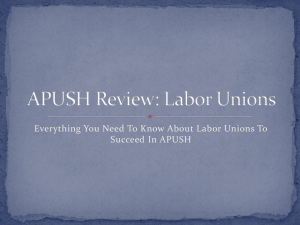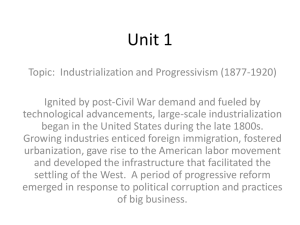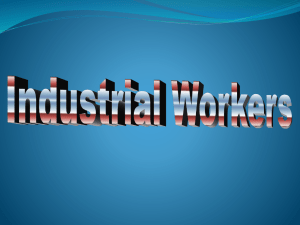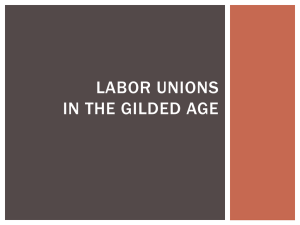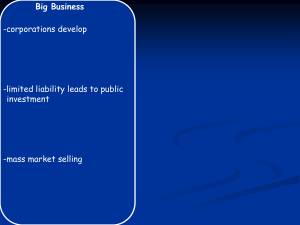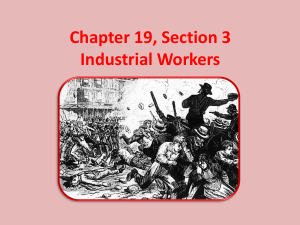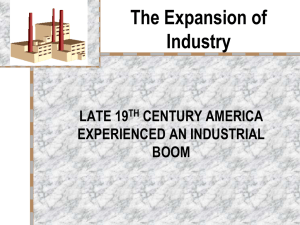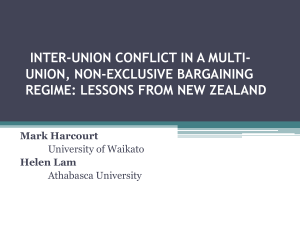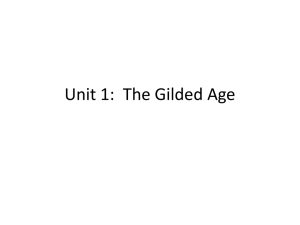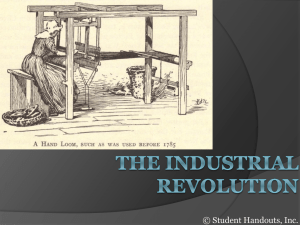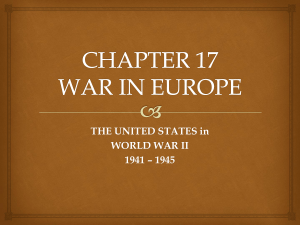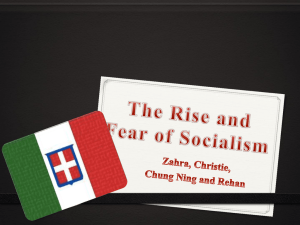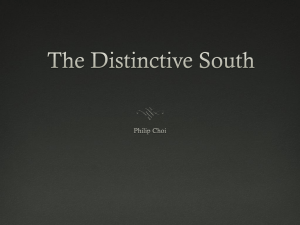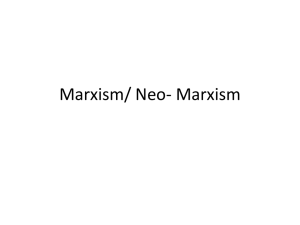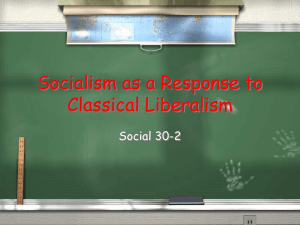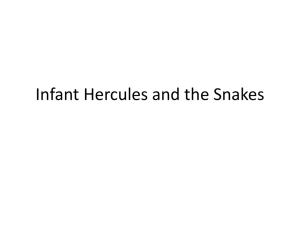Political Changes: Decline of Landed Aristocracy
advertisement
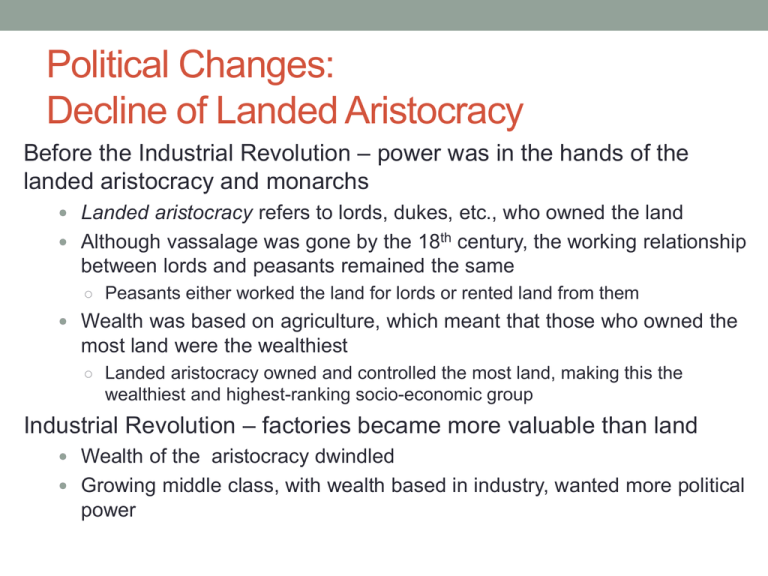
Political Changes: Decline of Landed Aristocracy Before the Industrial Revolution – power was in the hands of the landed aristocracy and monarchs Landed aristocracy refers to lords, dukes, etc., who owned the land Although vassalage was gone by the 18th century, the working relationship between lords and peasants remained the same ○ Peasants either worked the land for lords or rented land from them Wealth was based on agriculture, which meant that those who owned the most land were the wealthiest ○ Landed aristocracy owned and controlled the most land, making this the wealthiest and highest-ranking socio-economic group Industrial Revolution – factories became more valuable than land Wealth of the aristocracy dwindled Growing middle class, with wealth based in industry, wanted more political power Problem: British landowners and agriculturalists (lords and farmers) wanted high prices for their corn. Solution: Tariffs known as the Corn Laws established in 1815. Problem: The growing working class could not afford corn. •Solution: Repeal of the Corn Laws in 1846. Problem: The price of corn declined following the repeal of the Corn Laws, decreasing the wealth, power, and prestige of the landed aristocracy in Great Britain. •Solution: There was no solution. The landed aristocracy began its fall from economic and political power. Economic and political power shifted to the wealthy capitalist, middle, and working classes. Political Changes: Growth and Expansion of Democracy • The middle class grew during the Industrial Revolution • Gained more rights • The working class effectively began with the Industrial Revolution • The working class fought for rights in the workplace • The working class demanded and earned a voice in government Political Changes: Increased Government Involvement in Society Government actions to help workers Legalization of unions Established minimum wage Standards for working conditions Forms of social security Government actions to help consumers Regulation and inspection of goods and foodstuffs Government actions to help businesses Laws to stop or limit monopolies Some governments took control of vital industries Political Changes: Increased Power of Industrialized Nations • With wealth came power • Imperialism expanded • Imperialistic, industrialized nations built up their navies to gain and protect assets Political Changes: Nationalism and Imperialism Stimulated Increased production meant an increased need for raw materials Industrialized nations expanded their colonial empires and spheres of influence in their search for more raw materials Worldwide scramble for colonies Fought the peoples in the lands they controlled Fought one another for colonies and spheres of influence Governments saw imperialist expansion as the key to continued industrial growth and wealth Political Changes: Rise to Power of Businesspeople • Along with the working classes, businesspeople gained political rights • “Captains of industry” or “robber barons” – along with financiers • Wealth brought political influence Social Changes: Development and Growth of Cities Paris • 18th century 600,000 people • Circa 1900 – over 2,714,000 in the Paris urban area • Circa 2000 – over 11,000,000 in the Paris urban area London • 18th century – 500,000 people • Circa 1900 – over 6,200,000 in the London urban area • Circa 2000 - over 7,100,000 in the London urban area • Rural-to-urban migrants – people who left the countryside to live in cities • A sign of an industrialized nation is that a large proportion of the population lives and works in urban areas Social Change: Development and Growth of Cities Case Studies: Liverpool and Manchester Liverpool • 1800 – population under 100,000 • 1850 – population over 300,000 (part of the increase due to Irish fleeing the potato famine) • 1900 – population over 700,000 • Major British port city which grew during the Industrial Revolution • Population peaked in the 1930s and has been declining ever since due to the decline in manufacturing and imperialism Manchester • 1800 – population circa 328,000 • 1850 – population circa 1,037,000 • 1900 – population circa 2,357,000 • Nicknamed “Cottonopolis” in the mid-to-late 19th century because of its textile factories • Began to decline after the Industrial Revolution but has stabilized due to new industries and greater business diversification Social Changes: Improved Status and Earning Power of Women Initially, factory owners hired women and children because they worked for lower wages This brought many women, otherwise impoverished, to cities to work in factories Governments limited the work of children and, at times, of women Women gained economic power and independence Before industrialization, it was almost impossible for a woman to remain single and live on her own Factories and urban centers attracted women in large numbers Women fought for and eventually gained political rights Social Changes: Increase in Leisure Time Labor-saving devices invented and produced Vacuum cleaners Washing machines Refrigerators Entrepreneurs and inventors developed new forms of entertainment Moving pictures Amusement parks Birth of the weekend Traditionally, Western nations had Sunday (the Christian day of rest) as the only day off from work Saturday was added (after the struggles of Jewish labor unionists) to accommodate the religious observances of Jewish factory workers (whose Sabbath, or Shabbat, runs from Friday at sundown to Saturday at sundown) Social Changes: Population Increases Agricultural Revolution Increased food production Europe England Lower food prices People ate more More healthy babies were born Population skyrocketed • 1750 – 144,000,000 • 1900 – 325,000,000 • 1750 - 11,000,000 • 1900 - 30,000,000 • Many people immigrated to industrialized countries • Numerous nationalities to the United States • Irish to Manchester and Liverpool in England • Population growth in industrialized nations required growing even more food Social Changes: Problems • Monotony of assembly lines and factory life • Loss of craftsmanship in manufactured goods • War became more deadly as weapons became more technologically advanced and were mass produced • Economic insecurity – workers relied entirely on their jobs for sustenance Social Changes: Science and Research Stimulated Scientific and technological discoveries became profitable instead of simply beneficial Companies and governments were willing to invest in research and development Patent law Came into its modern form under England’s Queen Anne (reigned 1702-1714) Inventors have the exclusive right to produce their new inventions for a period of time THE LABOR MOVEMENT Changing Employee-Employer Relationships Domestic system Workers and employers knew each other personally Workers could aspire to become employers Factory system Workers no longer owned the means of production (machinery) Employers no longer knew workers personally ○ Factories often run by managers paid by the corporation Relationships between employers and employees grew strained Problems of the Factory System Factories were crowded, dark, and dirty Workers toiled from dawn to dusk Young children worked with dangerous machinery Employment of women and children put men out of work Women and children were paid less for the same work Technological unemployment – workers lost their jobs as their labor was replaced by machines Poor Living Conditions Factories driven solely by profit Businesses largely immune to problems of workers Factory (also company or mill) towns Towns built by employers around factories to house workers Workers charged higher prices than normal for rent, groceries, etc. ○ Workers often became indebted to their employers ○ Created a type of forced servitude as workers had to stay on at their jobs to pay their debts Considered paternalistic by workers ○ Some employers had workers’ interests at heart ○ But workers wanted to control their own lives Slum Living Conditions Factory towns – often built and owned by factories Not a strange concept to rural-to-urban migrants who were used to living on a lord’s estate or property Full of crowded tenements Few amenities Tenements – buildings with rented multiple dwellings Apartment buildings with a more negative connotation Overcrowded and unsanitary Workers were unsatisfied both inside and outside the factories Rise of Labor Unions Before labor unions, workers bargained individually – “individual bargaining” Before factories, a worker could bargain for better wages and working conditions by arguing his or her particular skills But in factories, work is routine and one worker can easily replace another With labor unions, workers bargained together as a group, or collective – “collective bargaining” Organized groups of workers elected leaders to bargain on their behalf Used tools (such as strikes) to gain rights Weapons Used by Unions and Employers Weapons Used by Employers • • • • • • • • • • • • • • At-will employment Blacklists Company unions Individual bargaining Injunctions Laws that limit union activities Lockouts Open shops Outsourcing Relocation Right-to-work laws Threat of foreign competition Welfare capitalism Yellow-dog contracts Weapons Used by Unions • • • • • • • • • • • • • Boycotts Check-offs Closed shops Collective bargaining Direct political action Favorable labor legislation Feather-bedding Lobbying Picketing Sabotage Strikes Union label Union shops Legal Protections for Workers • Limited hours for women • Later – equal pay for equal work • Eventual end to child labor • Schools and requirements for school attendance grew as children were removed from the workforce • Health and safety codes • Minimum wage • Legalization of unions Rights of Female and Child Workers Women and children could legally be paid less than men for the same work Factory owners were more willing to hire them Male workers grew resentful English child laborers England had a history (going back to the 17th century) of training pauper children (even those younger than five years old) in a trade Poor children followed their mothers into factories Early male-dominated unions fought to banish women and children from the workplace Eventually this strategy was abandoned Women eventually won right to equal pay for equal work Though women today, in reality, still earn less than men at the same types of work Labor Unions 1741 New York bakers quit work to protest local government setting the price of bread-possibly the first work stoppage in America. 1768 New York tailors strike to protest a wage cut. 1778 New York printers combine temporarily to ask for a wage increase, disband after winning it. 1786 Philadelphia printers strike. 1790 First textile mill, built in Pawtucket, RI, is staffed entirely by children under the age of 12. 1791 First Building Trades Strike: Philadelphia carpenters strike for a 10-hour day and overtime pay. 1792 The first local craft union formed for collective bargaining was organized by shoemakers in Philadelphia. 1794 The Philadelphia shoemakers reorganized as the Federal Society of Journeymen Cordwainers. The Typographical Society was formed by printers in New York City. 1799 The Philadelphia shoemakers in a "sympathy strike" to support a local toolmakers' strike. 1869 One of the earliest and most influential labor organizations, the Knights of Labor is founded by Philadelphia tailors. 1877 The first nationwide strike stops trains across the country. About 100,000 railroad workers are involved. Federal troops are called out to break the strike. 1886 Samuel Gompers founds the American Federation of Labor. 1886 During a labor demonstration in Chicago, a bomb explodes and rioting ensues. Anarchists are singled out and convicted of inciting violence during the Haymarket Square riot. 1892 Violence ends the Homestead steel strike in Homestead, Pennsylvania. 1894 The Pullman strike, involving 50,000 rail workers, ends in rioting and violence. 1905 The International Workers of the World (IWW), a radical union, is formed with the aim of overthrowing capitalism and replacing it with a socialist system. 1913 The U.S. government establishes the Department of Labor to protect the rights of workers. 1914 The Clayton Antitrust Act legalizes nonviolent strikes and boycotts. 1919 Over the course of the year, a record 4 million workers strike. 1935 The Wagner Act (also called the National Labor Relations Act) affirms the right of workers to unionize and requires employers to participate in collective bargaining. 1935 John L. Lewis breaks with the AFL and forms the Committee of Industrial Organization (CIO), later changing its name to the Congress of Industrial Organizations. 1937 United Auto Workers (UAW) sign a contract with General Motors after a successful sit-down strike in Flint, Michigan. 1938 The Fair Labor Standards Act establishes the minimum wage. 1947 The Taft-Hartley Labor Act limits some of the powers of unions and the circumstances under which they can strike. 1949 An amendment to the Fair Labor Standards Act of 1938 outlaws child labor. 1955 The largest U.S. labor organization, the AFL, merges with the CIO, forming the American Federation of Labor and Congress of Industrial Organizations (AFL-CIO). 1959 The Landrum-Griffin Act is passed to help eliminate union corruption. 1960 One third of all workers in the United States belong to a union. 1965 Mexican American labor leader Cesar Chavez garners national attention for the plight of farm workers by spearheading what becomes a 5-year California grape pickers strike. Chavez's union, the NFWA, primarily made up of Mexican Americans, joined forces with the Agricultural Workers Organizing Committee (AWOC),primarily made up of Filipino Americans, in undertaking the successful strike. 1970 The postal worker strike, involving 180,000 strikers, becomes the United States' largest public employee walkout. 1981 President Ronald Reagan orders the replacement of striking air traffic controllers with nonunion workers. 1997 Over the last several decades, union membership has dropped considerably. Only 14 percent belong to unions. 2005 The Teamsters and Service Employees unions announced their withdrawal from the AFL-CIO. The split is considered organized labor's worst crisis since 1935, when the CIO split from the AFL. A few days later, another one of the country's largest unions, the United Food and Commercial Workers, also withdraws. Review Questions 1. How and why did employer-employee relationships change during the Industrial Revolution? 2. Describe living conditions in factory towns. 3. Describe the weapons used by employers and unions. 4. Why was the establishment of yearly wages for members of parliament important to the British Labour party? 5. What are the advantages and disadvantages of unions for workers and consumers? Karl Marx Louis Blanc THE COOPERATIVE MOVEMENT AND SOCIALISM Cooperatives First cooperative – 1844 in Rochdale, England Formed to fight high food costs 30 English weavers opened a grocery store with $140 Bought goods at wholesale Members of cooperative bought goods at cost Non-members paid “retail” Profits split among members By 1857 – over 1000 members and £100,000 in annual profits Growth of cooperatives Spread to other industries – banking, building, insurance, printing, etc. By 1900 – 20% of Great Britain’s population had joined a cooperative Concept spread internationally Socialism Socialists – viewed the capitalist system as inherently wrong Belief that capitalism is designed to create poverty and poor working conditions because of its end goal of earning maximum profits for investors Socialism – government owns the means of production Belief that if the government (“the people”) owns the means of production, these factories and industries will function in the public (as opposed to private) interest Early Socialist Movement • First socialists were Utopians • Strove to create a fair and just system • Community divided tasks and rewards equitably • Robert Owen • Charles Fourier • Claude Saint-Simon • Louis Blanc Robert Owen (1771-1858) Utopian socialist Owned a textile factory in New Lanark, Scotland Set up a model community in New Harmony, Indiana Decreased working hours Improved working conditions and employee housing Shared management and profits with employees Proved that a socialist-based company could be profitable Charles Fourier (1772-1837) French philosopher Coined the term féminisme Advocated concern and cooperation as the means to create social harmony Considered poverty to be the main cause of society’s problems Envisioned workers (paid at least a minimum wage) living in “phalanxes” – communities living in a large shared structure Claude Henri de Saint-Simon 1760-1825 As a young man he was in the Thirteen Colonies as part of the French assistance effort during the American Revolution French socialist philosopher Believed all human beings naturally greedy and eager to obtain wealth and higher social positions These tendencies were to be eradicated through education Advocated an end to inheritances Movement of wealth from rich, powerful families to the state, which is an instrument of the people Louis Blanc (1811-1882) French socialist philosopher and politician Blamed society’s ills on the pressure of competition “From each according to his abilities, to each according to his needs.” Came to political power during the Revolution of 1848 Instituted labor reforms – believed everyone had the right to work Terrible June Days – forced from power after Blanc’s chief rival let Blanc’s public workshops (designed to give work to the unemployed) fail Returned to France, restored to power, and given a state funeral after his death His writings greatly influenced later socialists Karl Marx (1818-1883) German socialist (communist) philosopher Forced to leave Prussia for articles attacking the Prussian government Relocated to France where he was considered too radical Wrote Communist Manifesto with Friedrich Engels (1848) Relocated to England where he lived out the rest of his life Wrote Das Kapital – the “bible” of socialism (1867) “Religion is the opiate of the people.” Belief that religion is designed to keep people submissive to those in power by promising them that their reward is in heaven Marxism – Communism Economic Interpretation of History • Economic changes lead to historical changes. • Historically, the wealthy classes have held all power. Class Struggle • History has been a struggle between the rich and the poor. • In the Industrial Revolution, the struggle is between the capitalists (owners of the means of production) and the proletariat (workers). Surplus Value • Workers produce all wealth but receive only enough to survive. • “Surplus value” (profit) of the workers’ labor goes to the capitalists. Inevitability of Socialism • Industrial wealth leads to the concentration of wealth among fewer and fewer capitalists, while the living and working conditions of the proletariat grow worse. • The proletariat will eventually rebel and create a socialist state. Socialist and Communist Political Parties First International Founded by Marx and others in 1864 International Workingmen’s Association Urged proletariat to overthrow capitalism worldwide Broke apart in 1873 Second International Founded in 1889 National parties more concerned with the politics of their respective nations Broke apart during World War I Russian Revolution (1917) Communists – known as Bolsheviks, led by Vladimir Lenin, came to power following the overthrow of the tsar Left and right wings Socialists – right wingers – advocated socialist reforms through voting Communists – left wingers – advocated socialist reforms through revolution Political parties of both types have existed throughout Europe, the United States, and all over the world since around the turn of the last century Soviet-backed Communism Russian communism Bolsheviks (Communists or Reds) won the Russian civil war against the Whites World’s first socialist/communist state Comintern – Communist International Founded in Russia (Soviet Union) in 1919 Sought to spread worldwide communist revolution Disbanded during World War II Cominform – Communist Information Bureau Founded in Soviet Union in 1947 Disbanded in 1956 as part of de-Stalinization Soviet Union (and later China) spread communism through satellite states and via proxy wars during the Cold War Syndicalists and Anarchists Syndicalism and anarchism enjoyed popularity during the late 1800s and early 1900s Syndicalism Businesses and distribution of income managed by trade unions Unions exist separate from the state as opposed to being part of the state Anarchism Belief that all governments are bad for the people Advocates direct action to remove all forms of government Various individual ideologies for post-government societal organization Social Catholic Movement Opposed to the atheism of socialism Yet also opposed to uncontrolled capitalism Pope Leo XIII Advocated Catholic socialism in 1891 through his support of workers’ associations Pope Pius XI 1931 – condoned Catholic socialism while condemning communism Stated that workers should share in the profits and management of industry Followed by like-minded Protestant organizations Numerous Christian-based socialist political parties still active in Europe

